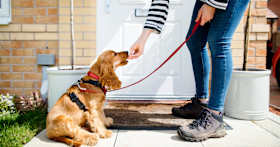Should You Board and Train a Newly Adopted Puppy?
It’s tempting to turn over your new dog to puppy boot camp — but it may not be worth it.
It’s tempting to turn over your new dog to puppy boot camp — but it may not be worth it.
by Nisha Gopalan, | January 28, 2025

Stereo Shot / Stocksy
Pet parents usually turn to boarding and training when they feel they need serious backup from a pro. And in the case of a puppy, their pet parent may want to establish a training structure that sets up their young dog for success amid all the mischievousness that puppies bring to households. Puppy boot camps promise fast results — but are they the right choice for your new dog? Here’s what you need to know before signing up for a board and train.
“Dog board and train” refers to a canine boarding school where a pet parent sends their dog away for obedience or behavior training. With a board-and-train program, your puppy will stay at their facility for the entirety of the course, unlike conventional day-training classes where coaching time is briefer, and a pet comes home after each session. Board-and-train programs typically last two or more weeks, depending on your pup’s background, temperament, and needed skills. (In less common circumstances, some programs may board your pup for the week and ask you to bring them home on weekends while their staff is off the clock.)
Boarding and training programs are personalized and immersive, meaning your pup will receive several hours of one-on-one training. These schools will typically emphasize repetitive training, with a focus on establishing desired behaviors while correcting certain unwanted ones. The more common puppy “curriculum” includes leash, crate, and boundary training.
That said, while these programs can offer a foundation in training essentials, they can be a bit of a mixed bag when it comes to quality. Different trainers bring different backgrounds and philosophies — some science-based, some...less so. Translation: do your homework.
There’s no shortcut when it comes to dog training. Realistically, canine behavior cannot completely change in a few weeks, particularly when you’re dealing with a puppy. Any effective transformation will take time. So, your pup may learn a new set of skills at a board-and-train facility, but this will only stick if you continue to nurture that change over time through consistent practice and positive reinforcement at home. This is especially important because your dog may associate certain wanted behaviors with the training facility, not with you or your home.
“Board-and-train…programs are only effective if the trainer teaches you some skills so that you can maintain your pet’s new behaviors after their training is done,” the American Society for the Prevention of Cruelty to Animals (ASPCA) says. “This method should also provide a training package with instructions for you.”
To be effective, the trainers (and later, pet parents) must implement positive reinforcement techniques — such as treats, toys, and/or affection — to reward desired behaviors throughout the process. Using coercive methods will merely rouse anxiety and fear in your puppy and possibly create a whole new set of behavioral issues upon leaving the board and train school.

koganami studio / Stocksy
Handing over your new canine family member to a board and train facility is a big step, and staying involved is key to their success. The American Kennel Club (AKC) strongly encourages you to ask a lot of questions before and during this process and get answers in writing. Below are a few questions you may want to ask.
Which behaviors will they focus on establishing in your puppy?
What positive reinforcement training strategies (rather than coercive methods) will be used with your puppy?
Are the trainers certified? If so, what are their credentials?
How do they handle basic care such as food, sleeping arrangements, and walks?
Can you swing by to see your puppy being trained?
Are there previous clients you can contact as references?
Can I observe a training session before committing?
How do you handle mistakes or undesired behavior?
Will my dog ever be left unattended? If so, for how long?
How much time will my dog spend in a crate or kennel?
What safety measures are in place to prevent injuries or escapes?
How will you keep me updated on my dog’s progress?
Because animal abuse often goes undetected at these schools, the American Kennel Club likewise suggests you inspect the training facilities yourself and observe the behaviors and reactions of the other dogs there.
Pet parents should understand that there are no quick ways to train a puppy (or a dog) — true change unfolds over time. In this way, boarding and training programs can come with false promises and actually present more problems than they solve. Here’s a look at the pros and cons of dog board-and-train programs.
It can be comforting to know that a dog boarding and training school can help, especially when your new puppy is being a handful. Their trainers are experienced with puppies and know how to help them socialize with other dogs there. They also teach them skills in controlled environments that you cannot create at home. This expertise undoubtedly provides temporary relief to frustrated pet parents.
While board and train programs may seem like tempting solutions, their success rates are not guaranteed. In fact, there are several reasons to consider why they may not be the best fit for you and your puppy.
Creates stress: Predictable routines are essential to training any dog. But let’s say you brought your new puppy home from a shelter, then sent them off to a board and train school, only to bring them back home again. With all these moves, your puppy isn’t afforded the time to properly settle into their new home, which can confuse them or even cause anxiety.
A lack of in-home training: Frequently, puppies will not understand that a set of rules established in one environment should apply to another environment. So there’s a very real chance that all those wonderful skills they acquired while away at training camp will not translate to your home.
The training isn’t with you: Training, while often necessary, is an important way to bond with your new dog, so you’re robbing both you and your new bestie of that experience. Additionally, just because your puppy has learned to appease a trainer at the board and train school doesn’t mean they’ll listen to you.
Inhumane training methods: You cannot control what you can’t see at a board and train center. Many of these businesses are ethical, but over the years, there have also been several reports of animal cruelty. This is an unfortunate risk you take when you drop off your puppy for weeks at a board and train facility.
Cost: These programs are very expensive (see below).

Jayme Burrows / Stocksy
Puppy board and train programs are expensive because you’re paying for 24/7 care for your dog, including food, shelter, exercise, individual training, and a facility’s operational costs. Preventative Vet estimates that board and train will set you back anywhere from $500 to more than $1,250 per week of training.
The first year you get a dog will always be more expensive than subsequent years — especially if you don’t go the adoption route, which often comes at a lower cost and includes vaccines, chips, spay/neutering, and other perks. That financial burden can multiply when you decide you need professional training for your pup.
But whether you’re able to save for some training or are on a very strict budget, there are other options out there.
Animal rescues and humane societies: Many perks come with adopting a dog, one of which is that the organization from where you saved your dog may provide free or discounted training with an animal behaviorist. This is usually the most affordable option.
Online training classes: Nonprofits, such as the ASPCA, offer affordable or free online training classes. They’re more reliable than random YouTube videos and feature their corps of experts.
Group classes: Many doggy daycare spots, pet stores, and other animal-related businesses offer training, too. These group environments provide great opportunities for your (vaccinated) pup to socialize. But because there are, unfortunately, stories of abuse, it’s critical to find one based on a veterinarian’s or friend’s recommendation. When you do decide on a place, ask questions about staff certifications and visit the facility to look for signs of abuse or neglect.
Private trainer: If you can invest a little more money into your puppy’s training, you can try a private trainer who’ll work with you. Just make sure they’re certified and use positive reinforcement methods. A good place to start looking is at the Association of Professional Dog Trainers website.
Not exactly: A dog can be trained, over two weeks, in a controlled environment, to adjust certain behaviors. However, over time, that progress will diminish without continued positive reinforcement, which will encourage them to stick to those new behaviors. In reality, the training process ends up being a long-term commitment.
After boarding and training, your dog will have picked up new skills. But as with humans, dogs don’t magically change in a limited amount of time. So it’s incumbent on you, the pet parent, to take whatever your dog may have learned and continue nurturing the desired behavior. You want to help them translate the new skills they learned in the context of the boarding environment to your home environment, which is very different in their minds.
Conaboy, Kelly. “You’ve Heard Dog Day-Care Horror Stories. Here’s How to Find a Safe One.” Washington Post, The Washington Post, 17 June 2024, www.washingtonpost.com/home/2024/06/17/dog-daycare-how-to-choose/. Accessed 9 Dec. 2024.
Gibeault, Stephanie. “Are Board and Train Programs a Solution to Your Training Problems?” American Kennel Club, 9 Nov. 2021, www.akc.org/expert-advice/training/board-and-train-programs/.
Madson, Cathy. “Board and Train for Dogs: Is It Worth It?” Preventivevet.com, Preventive Vet, 10 Nov. 2022, www.preventivevet.com/dogs/board-and-train-for-dogs.
Soares, John. “Board and Train in Dog Training Explained.” Happy Dogs Boarding and Training, 27 Mar. 2024, happydogsboardingandtraining.com/what-is-the-definition-of-board-and-train-in-dog-training/.
“The Problem with Board and Train Programs - National Association of Dog Obedience Instructors.” Nadoi.org, 2023, nadoi.org/blogpost/1968521/490904/The-Problem-with-Board-and-Train-Programs.

Nisha Gopalan has been a writer/editor for The New York Times, New York magazine, Entertainment Weekly, Variety, The Hollywood Reporter, and NYLON magazines. She currently resides in Los Angeles.

Behavior & Training

Behavior & Training

Behavior & Training

Adoption Advice
With the right care, puppy mill rescues can learn to trust and thrive.

Adoption Advice
If your dog is intense about protecting their food, it’s important to address their behavior. Here’s how.

Breed Info
From Border Collies to Golden Retrievers, we’ll point you toward the breeds who excel in obedience.


Behavior & Training
Is your new pup biting everything? Learn effective ways to curb this behavior by teaching bite inhibition.

Behavior & Training
Dogs need space to live their best lives, but how much is enough?